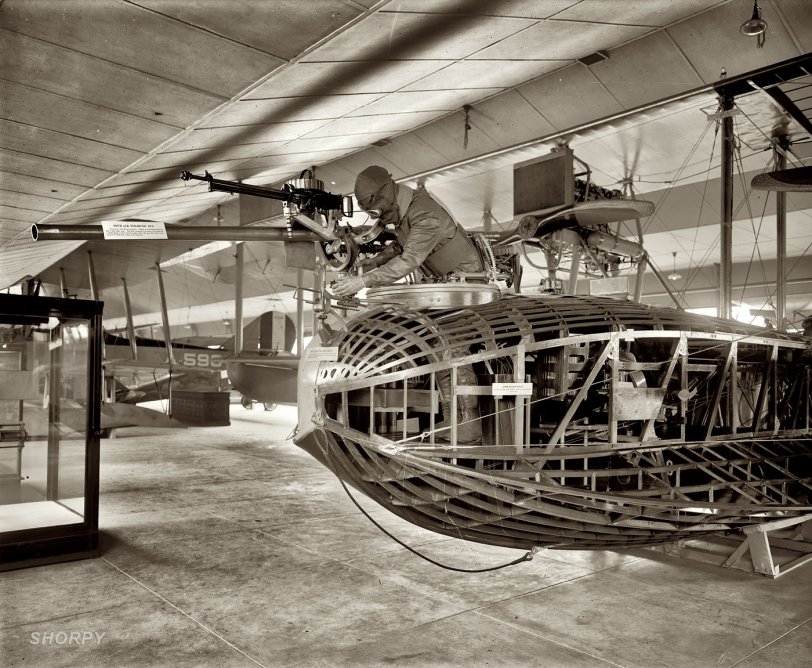


Framed or unframed, desk size to sofa size, printed by us in Arizona and Alabama since 2007. Explore now.
Shorpy is funded by you. Patreon contributors get an ad-free experience.
Learn more.

- Baldwin 62303
- Baldwin VO-1000
- Cold
- No expense spared
- Tough Guys
- Lost in Toyland
- And without gloves
- If I were a blindfolded time traveler
- Smoke Consumer Also Cooks
- Oh that stove!
- Possibly still there?
- What?!?
- $100 Reward
- Freeze Frame
- Texas Flyer wanted
- Just a Year Too Soon
- WWII -- Replacing men with women at the railroad crossing.
- Yes, Icing
- You kids drive me nuts!
- NOT An Easy Job
- I wonder
- Just add window boxes
- Icing Platform?
- Indiana Harbor Belt abides
- Freezing haze
- Corrections (for those who care)
- C&NW at Nelson
- Fallen Flags
- A dangerous job made worse
- Water Stop
Print Emporium
Top Gun: 1921

Circa 1921. Cutaway model of an F5L flying boat at the Smithsonian Institution in Washington. National Photo Company Collection glass negative. View full size.
Smithsonian Aircraft Museum
In about 1938/39 I saw the hull still on display in the metal building alongside the red brick Arts and Industries Building. So was Eddie Rickenbacher's SPAD from WW I.
Davis Gun
The gun tube behind the Lewis machine gun looked awfully big for an airframe of that era until I looked at the close up of the plaque in the earlier picture of this plane. It is a Davis gun, an early approach to eliminating recoil by expelling mass from the back to counteract mass of the projectile going out the muzzle. Until this picture, I didn't know that it had been applied to aircraft. Shorpy - always educational.
[There's also the label on the gun itself. - Dave]
Oops, sort of like not seeing the forest for the trees.

Where is it now?
It's been said that the Smithsonian never disposes of any exhibit; it may store the pieces, but never disposes of them.
I don't remember ever seeing this in the NASM, so it begs the question of where this particular exhibit is; it would be quite impressive to see it and realize how primitive these aircraft really were.
I mean, this is only 17-18 years after Kitty Hawk.
[The plane was returned to the Navy in 1930 and disposed of, except for the hull and a few other parts. - Dave]
From the Air & Space Museum Web site:
In March 1919, the Naval Aircraft Factory shipped a specially-built F5L to the 69th Regiment Armory in New York City for an aeronautical exhibition sponsored by the Aircraft Manufacturers Association. The airplane was a cutaway example to reveal the intricate method of construction. Although never intended for flight, the N.A.F. exhibition F5L was given U.S. Navy serial number A-3882. It was transferred to the Smithsonian Institution in 1920 and put on display. In 1930, in the course of reviewing plans to renovate the exhibition building in which the F5L was housed, the Smithsonian determined that it was not worth the labor and resources required to re-exhibit the airplane and proposed returning it to the Navy. The Navy assented to the request and made arrangements to retrieve the aircraft. In the end, the Smithsonian decided to retain the hull, a wing float, one propeller, and a bomb. The Navy disposed of the wings and most of the rest of the aircraft, but salvaged the Liberty engines and other usable small components. The parts of F5L serial numberA-3882 retained by the Smithsonian in 1930 are all that survive of any Felixstowe flying boat.
View
Uncomfortable yes, but think of the view that the gunner must have had!
Cramped quarters
There appears to be a solid bulkhead directly behind the forward observer / gunner's station in this aircraft, which to me means that once he was at his station, there he stayed for the duration of the flight. Regardless of flying suit protection, the 100 mph slipstream would've been very uncomfortable after about 15 minutes. This generation of aircrew should be admired for their courage and fortitude.
























On Shorpy:
Today’s Top 5